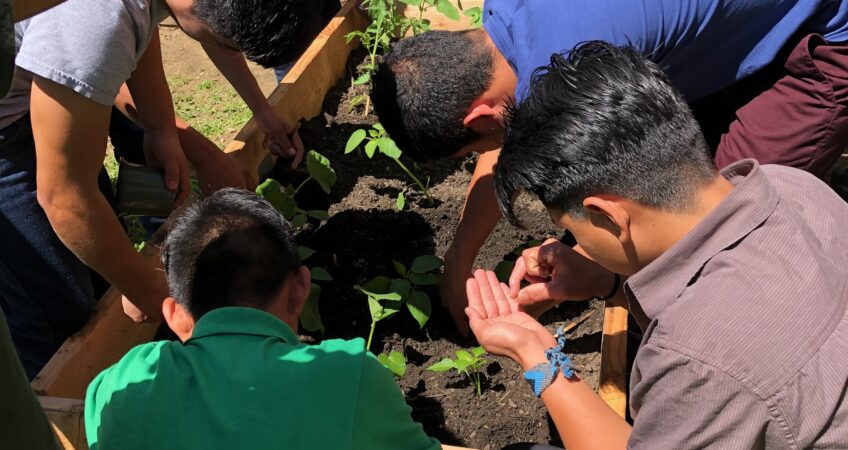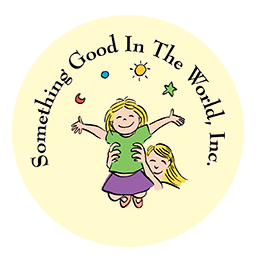
Daring to Dream
“Go confidently in the direction of your dreams. Live the life you have imagined.” – Henry David Thoreau
I have the privilege to bring vulnerable children, refugees, at-risk youth, and traumatized teens from public schools, day care centers and shelters to farms, and the honor to witness them experiencing the joy of being in nature, feeling free, opening their minds and hearts to what else is possible. There is no greater happiness than facilitating their learning process, including running, rolling down a grassy hillside, climbing a tree, pumping a seesaw, riding a tire swing, or just sitting and observing nature, taking in the view, having a chance to breathe and be still, be oneself, be a child.

This week, I had the incredible opportunity to help students in a local high school, at a shelter for trafficked children, and at a center for Central American refugees to create their own Children’s Peaceful Gardens, following the principles of sustainable design that Something Good in the World established as a template in 2000, and which was recognized by the Jane Goodall Institute and the United Nations in 2016 as a place of Peace and Sustainability. In one school, the students named theirs the “Mindfulness Garden,” in one shelter, they call it the “Sanctuary Garden,” in another, “The Refuge Garden,” but no matter what, it serves the same purpose: to grow native plants, herbs, flowers, fruits, and vegetables, and to create a space within which to enjoy peace, contemplation, quiet conversation, and well being.
Is there any reason to bring children who have experienced trauma into nature, onto farms, and to design and plant their own gardens? Famed neurologist Oliver Sacks would say there is:
“As a writer, I find gardens essential to the creative process; as a physician, I take my patients to gardens whenever possible. All of us have had the experience of wandering through a lush garden or a timeless desert, walking by a river or an ocean, or climbing a mountain and finding ourselves simultaneously calmed and reinvigorated, engaged in mind, refreshed in body and spirit. The importance of these physiological states on individual and community health is fundamental and wide-ranging.”

There is also the power of planting a seed, and even if one will not be there to witness its almost magical growth into a plant, even if one will not get to taste the fruits of these labors, just to know that it is possible, and that some one else will enjoy it is uplifting, because this would not happen if the first seed were not planted.
At the end of a farm visit, I asked refugee boys from Honduras, Guatemala, and El Salvador, what did they want to do for work, in their lives, what were they dreaming of now that they were here in the United States? Each one of the 14 boys said the same word to me, “Construction.” I was shocked. No one wanted to be a doctor? A farmer? A scientist? Anything? Wasn’t there something they were passionate about learning and doing, now that they were here? “Sure,” they smiled, but it was an uneasy smile. They looked down; they shifted on their feet. It was explained to me by the translator, who works with Central American refugees on a daily basis, that they cannot dream… yet. Their children will dream, she told me.
The translator explained that most people do not understand that for many refugee children, their parents are here illegally as well, and that creates a bubble of limited possibilities for them, especially as they near age 18. If they have a support system, yes, they can go to school, learn English, and envision life beyond minimum wage. But to become a doctor, she said, they need a social security card.

So, we planted seeds. Corn, maiz, the girls wanted to plant most. Beans, frijoles, the boys wanted to plant next. Thinking, this is New York, I added squash, ayote, so there could be a Three Sisters Garden at their shelter, the Native American trio of corn, squash and beans that works together in harmony like a family.
Every shelter I visit, we design a new Children’s Peaceful Garden, and we plant seeds and bulbs and perennial plants, because even if the children won’t be there to see them come to fruition, other children will. And the ones who plant these, love the idea of some one else coming in the future, knowing that they themselves were the first to start the garden. There is power in that.
These are children who have been told they can’t. It reminds me of one of my favorite books from childhood, “The Carrot Seed,” by Ruth Krauss. A little boy plants a carrot seed and every member of his family, one by one, says, “I’m afraid it won’t come up.” But the little boy weeds the ground and waters the seed, and nothing comes up. Everyone keeps telling him that it won’t come up. But he still keeps watering and weeding. And one day… a giant carrot comes up, “just as the little boy had known it would.”
A Children’s Peaceful Garden makes dreaming possible…
